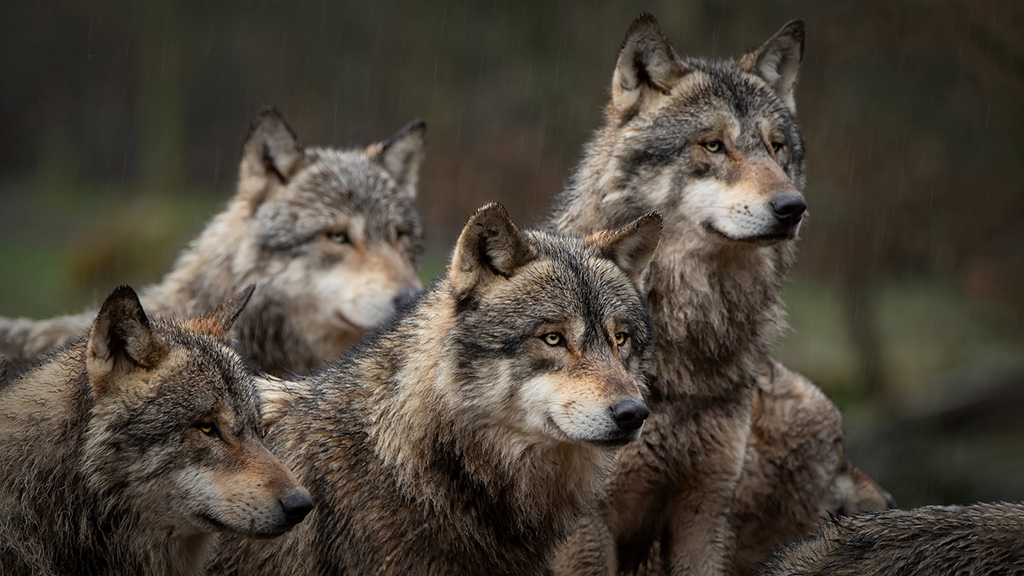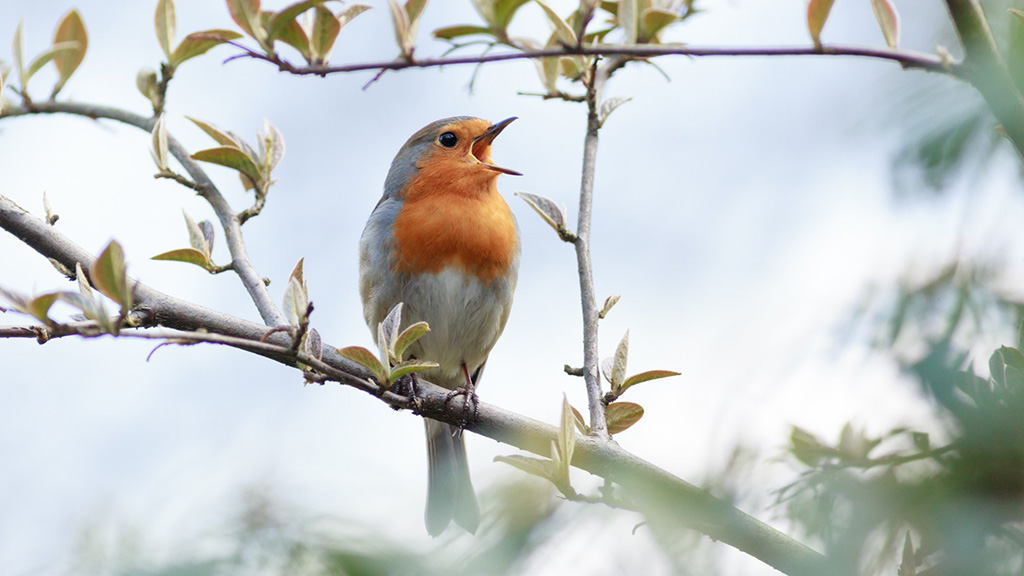Physical Adaptations
Adaptaciones Físicas

A pack of grey wolves in the forest
Una manada de lobos grises en el bosque
English | LEVEL A

A pack of grey wolves in the forest
Una manada de lobos grises en el bosque
Have you ever thought about how plants and animals survive in different places? Nature gives them special tools called adaptations. These adaptations help them live where they are. Let’s learn about some of these cool features!
An adaptation is a special body part or behavior that helps a plant or animal survive. It could be something on their body, like fur, or something they do, like hiding. For example, a polar bear has thick fur to stay warm in the cold Arctic. That’s a physical adaptation.
Plants have neat ways to survive in different places. In hot, dry deserts, plants like cacti have thick stems to store water. They have spines instead of leaves to save water and protect themselves from animals.
Some plants live in or near water. Water lilies have big, flat leaves that float. These leaves soak up sunlight to make food. The leaves also have a waxy coating to stay dry. Their roots stick in the mud to keep them in place.
Plants in forests often compete for sunlight. Tall trees grow high to reach the sun. Other plants, like ferns, have big leaves to catch as much sunlight as they can.
Animals have amazing ways to survive too. Many animals use colors and patterns to hide. This is called camouflage. A chameleon can change its color to blend in. Arctic foxes are white in winter to match the snow, but turn brown during the summer to match dirt and rocks.
Some animals even copy other animals to stay safe! A harmless milk snake looks like a dangerous coral snake. Predators leave the milk snake alone because they think it’s poisonous.
Animals also have special body parts. Birds have wings to fly beaks to eat different kinds of food. Fish have fins to swim and gills to breathe underwater. Elephants have trunks to grab food and water.

A robin sings her song
Un petirrojo canta su canción
Adaptations are important because they help plants and animals survive. Without them, they couldn’t find food, stay safe, or have babies.
Nature is full of amazing adaptations! By learning about them, we can understand and enjoy the wonderful world around us. Next time you see a plant or animal, think about how it survives and thrives!
¿Alguna vez has pensado en cómo las plantas y los animales sobreviven en diferentes lugares? La naturaleza les otorga herramientas especiales llamadas adaptaciones. Estas adaptaciones les ayudan a vivir donde están. ¡Aprendamos algunas de estas características tan interesantes!
Una adaptación es una parte especial del cuerpo o un comportamiento que ayuda a una planta o un animal a sobrevivir. Puede ser algo en su cuerpo, como el pelaje, o algo que hacen, como esconderse. Por ejemplo, un oso polar tiene un pelaje grueso para mantenerse caliente en el frío Ártico. Eso es una adaptación física.
Las plantas tienen formas ingeniosas de sobrevivir en diferentes lugares. En desiertos cálidos y secos, plantas como los cactus tienen tallos gruesos para almacenar agua. Tienen espinas en lugar de hojas para conservar agua y protegerse de los animales.
Algunas plantas viven en el agua o cerca de ella. Los nenúfares tienen hojas grandes y planas que flotan. Estas hojas absorben la luz solar para producir alimento. Las hojas también tienen una capa cerosa para mantenerse secas. Sus raíces se hunden en el barro para mantenerse en su lugar.
Las plantas de los bosques a menudo compiten por la luz solar. Los árboles altos crecen para alcanzar el sol. Otras plantas, como los helechos, tienen hojas grandes para captar la mayor cantidad de luz solar posible.
Los animales también tienen maneras asombrosas de sobrevivir. Muchos animales usan colores y patrones para esconderse. Esto se llama camuflaje. Un camaleón puede cambiar de color para mimetizarse. Los zorros árticos son blancos en invierno para combinar con la nieve, pero se vuelven marrones durante el verano para combinar con la tierra y las rocas.
¡Algunos animales incluso copian a otros animales para mantenerse a salvo! Una serpiente lechosa inofensiva se parece a una peligrosa serpiente coral. Los depredadores la dejan en paz porque creen que es venenosa.
Los animales también tienen partes especiales del cuerpo. Las aves tienen alas para volar y picos para comer diferentes tipos de alimento. Los peces tienen aletas para nadar y branquias para respirar bajo el agua. Los elefantes tienen trompas para agarrar comida y agua.

A robin sings her song
Un petirrojo canta su canción
Las adaptaciones son importantes porque ayudan a las plantas y a los animales a sobrevivir. Sin ellas, no podrían encontrar alimento, mantenerse a salvo ni tener crías. ¡La naturaleza está llena de adaptaciones asombrosas! Al aprender sobre ellas, podemos comprender y disfrutar del maravilloso mundo que nos rodea. La próxima vez que veas una planta o un animal, ¡piensa en cómo sobrevive y prospera!
Have you ever wondered how plants and animals survive in different places? Nature has given them special tools called adaptations. These adaptations help them live in their environment. Let’s explore some of these fascinating features!
An adaptation is a special feature or behavior that helps a plant or animal survive. Adaptations can be physical, like a body part, or behavioral, like the way an animal acts. For example, a polar bear's thick fur is a physical adaptation that keeps it warm in the cold Arctic.
Plants have many cool adaptations that help them live in various places. For example, deserts are very dry and hot. Plants like cacti have adapted to survive in these tough conditions. Cacti have thick stems that store water. They also have spines instead of leaves to reduce water loss and protect them from animals.
Some plants live in or near water. Water lilies have large, flat leaves that float on the surface of the water, soaking up sunlight to make food. The leaves’ waxy coating keeps them dry even in wet conditions. Their roots are also anchored in the muddy bottom to keep them stable.
Plants in the forest often need to compete for sunlight. Some trees grow very tall to reach the sunlight. Other plants, like ferns, have large, broad leaves to catch as much light as possible.
Animals also have amazing adaptations to help them survive. Many animals have colors and patterns that help them blend in with their surroundings. This is called camouflage. For example, a chameleon can change its color to blend in with its surroundings. Arctic foxes turn white in the winter to blend in with snow and brown in the summer to match the dirt and rocks.
Some animals mimic other animals or objects to protect themselves. For example, the harmless milk snake looks like the dangerous coral snake. Predators avoid the milk snake because they think it's poisonous.
Animals have special body parts that help them survive. Birds have wings to fly and beaks to eat different kinds of food. Fish have fins to swim and gills to breathe underwater. Elephants have long trunks to grab food and water.

A robin sings her song
Un petirrojo canta su canción
Adaptations are important because they help plants and animals survive in their habitats. Without these special features and behaviors, they would not be able to find food, stay safe, and reproduce.
Nature is full of wonderful adaptations that help plants and animals live in different environments. By learning about these adaptations, we can better understand and appreciate the amazing world around us. So next time you see a plant or animal, think about the special tools it has to survive and thrive!
¿Te has preguntado alguna vez cómo sobreviven las plantas y los animales en diferentes lugares? La naturaleza les ha otorgado herramientas especiales llamadas adaptaciones. Estas adaptaciones les ayudan a vivir en su entorno. ¡Exploremos algunas de estas fascinantes características!
Una adaptación es una característica o comportamiento especial que ayuda a una planta o un animal a sobrevivir. Las adaptaciones pueden ser físicas, como una parte del cuerpo, o conductuales, como la forma de actuar de un animal. Por ejemplo, el pelaje grueso del oso polar es una adaptación física que lo mantiene caliente en el frío Ártico.
Las plantas tienen muchas adaptaciones interesantes que les ayudan a vivir en diversos lugares. Por ejemplo, los desiertos son muy secos y calurosos. Plantas como los cactus se han adaptado para sobrevivir en estas duras condiciones. Los cactus tienen tallos gruesos que almacenan agua. También tienen espinas en lugar de hojas para reducir la pérdida de agua y protegerse de los animales.
Algunas plantas viven en el agua o cerca de ella. Los nenúfares tienen hojas grandes y planas que flotan en la superficie del agua, absorbiendo la luz solar para producir alimento. La capa cerosa de las hojas las mantiene secas incluso en condiciones de humedad. Sus raíces también están ancladas en el fondo fangoso para mantenerlas estables.
Las plantas del bosque a menudo necesitan competir por la luz solar. Algunos árboles crecen muy altos para alcanzar la luz solar. Otras plantas, como los helechos, tienen hojas grandes y anchas para captar la mayor cantidad de luz posible.
Los animales también cuentan con adaptaciones asombrosas que les ayudan a sobrevivir. Muchos animales tienen colores y patrones que les ayudan a mimetizarse con su entorno. Esto se llama camuflaje. Por ejemplo, un camaleón puede cambiar de color para mimetizarse con su entorno. Los zorros árticos se vuelven blancos en invierno para mimetizarse con la nieve y marrones en verano para combinar con la tierra y las rocas.
Algunos animales imitan a otros animales u objetos para protegerse. Por ejemplo, la inofensiva serpiente lechosa se parece a la peligrosa serpiente coral. Los depredadores evitan a la serpiente lechosa porque creen que es venenosa.
Los animales tienen partes especiales del cuerpo que les ayudan a sobrevivir. Las aves tienen alas para volar y picos para comer diferentes tipos de alimentos. Los peces tienen aletas para nadar y branquias para respirar bajo el agua. Los elefantes tienen trompas largas para atrapar alimento y agua.

A robin sings her song
Un petirrojo canta su canción
Las adaptaciones son importantes porque ayudan a las plantas y a los animales a sobrevivir en sus hábitats. Sin estas características y comportamientos especiales, no podrían encontrar alimento, mantenerse a salvo ni reproducirse.
La naturaleza está llena de maravillosas adaptaciones que ayudan a las plantas y a los animales a vivir en diferentes entornos. Al aprender sobre estas adaptaciones, podemos comprender y apreciar mejor el asombroso mundo que nos rodea. Así que, la próxima vez que veas una planta o un animal, ¡piensa en las herramientas especiales que tiene para sobrevivir y prosperar!